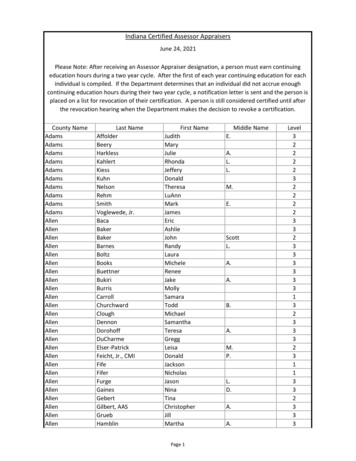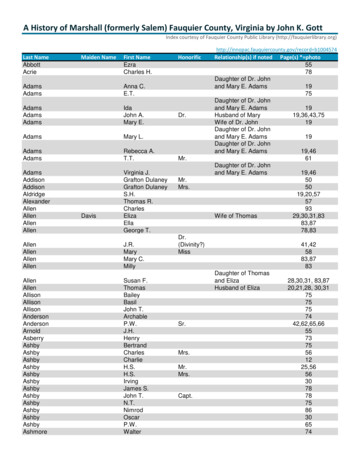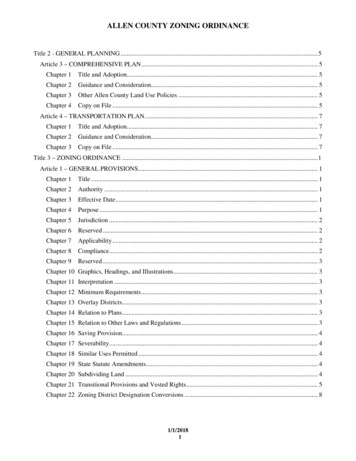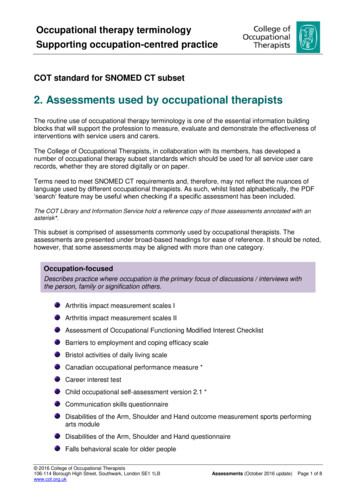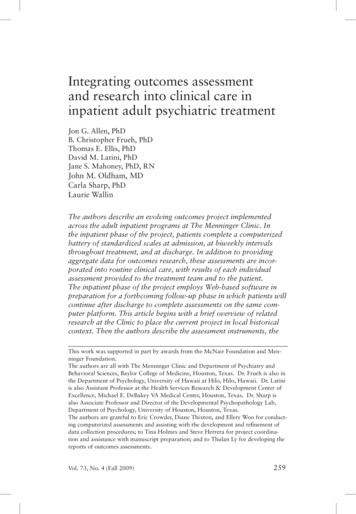
Transcription
ing outcomes assessmentand research into clinical care ininpatient adult psychiatric treatmentJon G. Allen, PhDB. Christopher Frueh, PhDThomas E. Ellis, PhDDavid M. Latini, PhDJane S. Mahoney, PhD, RNJohn M. Oldham, MDCarla Sharp, PhDLaurie WallinThe authors describe an evolving outcomes project implementedacross the adult inpatient programs at The Menninger Clinic. Inthe inpatient phase of the project, patients complete a computerizedbattery of standardized scales at admission, at biweekly intervalsthroughout treatment, and at discharge. In addition to providingaggregate data for outcomes research, these assessments are incorporated into routine clinical care, with results of each individualassessment provided to the treatment team and to the patient.The inpatient phase of the project employs Web-based software inpreparation for a forthcoming follow-up phase in which patients willcontinue after discharge to complete assessments on the same computer platform. This article begins with a brief overview of relatedresearch at the Clinic to place the current project in local historicalcontext. Then the authors describe the assessment instruments, theThis work was supported in part by awards from the McNair Foundation and Menninger Foundation.The authors are all with The Menninger Clinic and Department of Psychiatry andBehavioral Sciences, Baylor College of Medicine, Houston, Texas. Dr. Frueh is also inthe Department of Psychology, University of Hawaii at Hilo, Hilo, Hawaii. Dr. Latiniis also Assistant Professor at the Health Services Research & Development Center ofExcellence, Michael E. DeBakey VA Medical Center, Houston, Texas. Dr. Sharp isalso Associate Professor and Director of the Developmental Psychopathology Lab,Department of Psychology, University of Houston, Houston, Texas.The authors are grateful to Eric Crowder, Diane Thixton, and Ellery Woo for conducting computerized assessments and assisting with the development and refinement ofdata collection procedures; to Tina Holmes and Steve Herrera for project coordination and assistance with manuscript preparation; and to Thulan Ly for developing thereports of outcomes assessments.Vol. 73, No. 4 (Fall 2009)259
Allen et al.ways in which the assessments are integrated into clinical care, plansfor follow-up assessments, the central role of information technologyin the development and implementation of the project, the primaryresearch questions, and some of the major challenges in implementing the project. The article concludes with a discussion of the ways inwhich the project can serve as a platform for a broad future researchagenda. (Bulletin of the Menninger Clinic, 73[4], 259-295)To remain viable, healthcare services must be linked to objectiveand standardized measures of clinical outcomes—if not driven bythem (Fonagy, 1999; Institute of Medicine, 2001; Kane, 2006).Porter and Teisberg (2006) are emphatic on this point: “Mandatory measurement and reporting of results is perhaps the singlemost important step in reforming the health care system” (p. 7,emphasis in original). Yet, as these authors make plain, progress inbasing clinical practice on outcomes data has been slow throughout general medicine, although there are exemplary exceptions.Progress also has been slow in inpatient psychiatry, notwithstanding the availability of a plethora of standardized measures (Rush,First, & Blacker, 2008). In this article, we endeavor to delineate therole for integrating outcomes assessment and research into clinical care in inpatient psychiatric treatment. We describe a currentlongitudinal, hospital-wide outcomes assessment effort under wayat The Menninger Clinic, beginning with a historical context forsuch assessments and concluding with a broader research agendafor the future.Historical context of outcomesassessments at The Menninger ClinicRecognition of the need to integrate research and practice at TheMenninger Clinic is not new. In 1937, the first volume of the Bulletin of the Menninger Clinic included an issue (no. 6) devoted tothe potential interface between clinical practice and psychological research. The editors’ introduction to this issue acknowledgedthe challenges in bringing together clinical psychiatry and psychological science but included the hopeful note that psychologicaltest data were routinely used in case discussions. Begun in 1954,260Bulletin of the Menninger Clinic
Integrating assessment and researchthe Psychotherapy Research Project (Horwitz, 1974; Robbins &Wallerstein, 1956; Sargent, Horwitz, Wallerstein, & Appelbaum,1968; Wallerstein, 1986) was a notably ambitious effort to research clinical practice, and one that made extensive use of psychological test data (Appelbaum, 1977). The project was designedto assess mechanisms of change in outpatients referred for psychoanalysis and psychoanalytically oriented psychotherapy. Amongthe influential conclusions of this landmark outcomes study wasthe recognition that the therapeutic alliance played a central rolein the unanticipated mutative effects of supportive psychotherapyprocesses—a conclusion that was at variance with the initial assumption that interpretive interventions related to early developmental conflicts would be required for substantial (“structural”)change (Horwitz, 1974). This conclusion led to further studies ofthe relations between therapist interventions and the quality of thetherapeutic alliance, a research program focused on patients withborderline personality disorder (Allen et al., 1996; Allen, Gabbard,Newsom, & Coyne, 1990; Colson et al., 1988; Gabbard et al.,1988; Horwitz et al., 1996).Psychotherapy has remained a central intervention at The Menninger Clinic, albeit currently in the context of hospital treatment.As Will Menninger’s (1982) Guide to the Order Sheet (first copyrighted in 1939) attests, clinical outcomes in hospital treatment areassociated with a host of interventions and potentially therapeutic relationships in a complex social milieu. Given the prominentrole of inpatient treatment at The Clinic, clinical research after thePsychotherapy Research Project increasingly focused on hospitaltreatment per se. One legacy of the psychotherapy research wasan examination of treatment alliances in the inpatient milieu (Allen, Deering, Buskirk, & Coyne, 1988; Allen, Tarnoff, & Coyne,1985). Consistent with the institution’s focus on treatment resistance, a substantial research effort was directed to addressingproblems with patients whose illnesses were perceived as “difficultto-treat” in the hospital milieu (Allen et al., 1986; Colson et al.,1985; Colson, Allen, Coyne, Deering et al., 1986; Colson, Allen,Coyne, Dexter et al., 1986). At the same time, research was directed toward determining patient characteristics related to suitabilityfor long-term treatment (Allen et al., 1984; Allen, Scovern, Logue,& Coyne, 1988), and we conducted selected inpatient outcomesVol. 73, No. 4 (Fall 2009)261
Allen et al.(Allen et al., 1987) and follow-up studies of adult patients hospitalized for extended periods with trauma-related problems (Allen,Coyne, & Console, 2000) and personality disorders (Gabbard etal., 2000). In addition, the hospital initiated work on developing acomputerized medical record that would incorporate researchable,quantitative data into routine clinical assessment and documentation (Clifford, 1999; Fonagy, 1999; Graham, 1999).Yet inpatient psychiatric treatment has been a moving target,and nowhere is that phenomenon more conspicuous than in thehistory of The Menninger Clinic. Reflecting national trends, lengthsof stay at the Clinic decreased dramatically during the 1980s and1990s. This changing clinical landscape ultimately eventuated inthe decision to forge a partnership with a medical school for thepurpose of sustaining and enhancing research and education aswell as clinical practice. This decision had a significant impact onshaping clinical services: In preparation for relocation from Topeka, Kansas, to Houston, Texas, to partner with the Baylor Collegeof Medicine, the Clinic was downsized to a number of specializedinpatient programs, with typical lengths of stay in adult clinicalservices ranging from 4 to 8 weeks. Albeit quite lengthy by contemporary standards, these lengths of stay were dramatically reducedby comparison to previous decades, when stays of a year or morewere commonplace.This major transition interrupted the effort to create a researchable electronic medical record and has been associated with a gradual reconfiguration of programs that calls for renewed efforts toassess outcomes. The hospital adopted a primary clinician model(Haslam-Hopwood, 2003) in which psychologists and social workers carry the role of coordinating the patient’s treatment programin collaboration with a multidisciplinary team that includes the patient as a key member (Munich, 2000). Currently, four adult inpatient programs are operating: the Professionals in Crisis program(Bleiberg, 2006); the COMPASS program for young adults (Poa,2006); the HOPE program for patients with relatively chronic disorders; and the Comprehensive Psychiatric Assessment Service,which offers comprehensive inpatient assessment and briefer inpatient treatment. The Adolescent Assessment and Treatment Program has initiated a separate outcomes assessment project based262Bulletin of the Menninger Clinic
Integrating assessment and researchon an extension of the Mentalization-Based Treatment model(Bateman & Fonagy, 2006, 2008) to adolescents with emergingpersonality disorders. This more theoretically focused effort assessing treatment outcomes for adolescent patients has been developedunder the auspices of the Child and Family Program (see Sharp etal., this issue).Prior to the transition from Kansas to Texas, for quality assurance purposes, we had collected limited treatment-evaluation datafor adult inpatients that included a brief, standardized measure ofprominent symptoms (the Behavioral and Symptom IdentificationScale [BASIS-32]; Eisen, Normand, Belanger, Gevorkian, & Irvin,2004) as well as a measure of patients’ perceptions of the qualityof care. This latter measure, Your Treatment and Care, evolvedover time in relation to changes in treatment programs and emerging quality assurance concerns (Allen & Fultz, 2003; Frager et al.,1999; Webb, Clifford, & Graham, 1999). Months after the relocation from Kansas to Texas, we resumed collecting these data forquality assurance purposes, and the (unpublished) findings werereassuring in showing stability across time—notwithstanding thesubstantial challenges associated with such a major transition. Albeit reassuring, the results obtained prior and subsequent to the relocation were limited in value by virtue of far less than full patientparticipation, resulting in part from the lack of a project-dedicatedresearch staff.The current hospital-wide adult outcomes assessment effortIn addition to the need for healthcare organizations to apply quality improvement initiatives and outcomes evaluation to the delivery of care, many experts have called for evidence-based clinicalpractice (American Nurses Association, International Society ofPsychiatric Nursing, American Psychiatric Nursing Association,2007; American Psychiatric Association, 2009; American Psychological Association, 2009; National Association of Social Workers,2009). This approach relies on a translation of existing researchand best practice guidelines to clinical practice. Others have suggested a more direct approach known as practice-based evidencethat translates real-time outcomes to clinical decision-making atVol. 73, No. 4 (Fall 2009)263
Allen et al.the point of service (Horn & Gassaway, 2007; Lambert & Burlingame, 2007; McDonald & Viegbeck, 2007; Westfall, Mold, &Fagnan, 2007).Moving from a quality assurance to a practice-based evidenceand research orientation, we incorporated four key modificationsinto the current Adult Outcomes Project. First, we decided to incorporate the results of assessments into routine clinical care, withthe findings reported to the clinician coordinating the patient’s carewho, in turn, reviews the findings with the patient and communicates them to the treatment team. Second, while aspiring to keepthe assessment brief, we added some new measures to increase itsclinical and research utility. Third, to gauge patients’ progress, weinstituted biweekly assessments in addition to the admission anddischarge assessments. Fourth, we employed a cadre of research assistants to engage patients in the assessments; this process uses laptop computers and Web-based software such that results are automatically incorporated into a hospital-wide database. Notably, notonly does evidence support the validity of computerized assessmentbut also some research suggests that respondents may be more willing to reveal sensitive information when the data are collected viacomputers (Turner et al., 1998; Wolford et al., 2008).The first phase of the project, implemented in April 2008, involved establishing the inpatient assessments. The second phase,planned for the latter half of 2009, will implement longitudinalfollow-up assessments (up to 18 months postdischarge). This article proceeds in the following steps: We enumerate the assessmentinstruments; we discuss our initial experience in incorporating thefindings into clinical care in the inpatient phase of the project; wedescribe the protocol for the follow-up study; we note the crucialrole of the information technology department in the developmentand implementation of the project; we delineate our major treatment evaluation and research questions; we describe the barriers toand challenges involved in implementing the project; and we conclude with our plans to expand the research aims of the project inthe future. We report initial results from the inpatient assessmentsin a companion article (see Latini et al., this issue).264Bulletin of the Menninger Clinic
Integrating assessment and researchAssessment InstrumentsTo facilitate implementation of research-based assessments into acomplex clinical system, we have begun with a “minimalist” approach to assessment, designing a brief screening battery that canbe completed easily by most patients in less than an hour. Table 1provides an overview of the measures employed in the inpatientphase and the planned follow-up phase. The admission assessmentconsists of two questionnaires we designed to provide demographic and personal history information as well as five standard scalesto assess symptoms and personality problems. We also assess patients’ perceptions of the quality of their care along with their treatment engagement and working alliances. In addition to repeatinga number of the inpatient assessments, the follow-up phase willinclude a measure of the patients’ experience of the transition topostdischarge care as well as assessment of treatment adherenceand perception of the quality of outpatient care.QuestionnairesPersonal Information. This questionnaire includes demographicinformation and aspects of past history potentially pertinent totreatment and outcome, namely, exposure to traumatic events,substance abuse, legal problems, extent of prior psychotherapy andhospitalization, and stopping medication or psychotherapy againstadvice (see Appendix for content that goes beyond demographicdata).Health, Social Support, and Stress. This brief questionnaire (seeAppendix) will be added to the inpatient admission assessment asa baseline when the follow-up project is implemented. The itemsaddress several facets of recent history, including health-related behavior, social support, and exposure to recent stressors; these questions will be repeated at follow-up assessment points.Standardized ScalesRAND Short-Form 36 Health Survey (SF-36, version 1). TheRAND SF-36 (Ware, Snow, Kosinski, & Gandek, 1993) is a widelyused instrument composed of eight scales to assess several aspectsof physical and emotional health and well-being: physical functioning, impact of physical health on role functioning, bodily pain,Vol. 73, No. 4 (Fall 2009)265
266xxxxxxHealth, Social Support, StressInventory of Interpersonal ProblemsRelationship QuestionnaireRAND SF-36 v.1 *BASIS-24 **Beck Depression InventoryXxx*RAND SF-36 RAND Short Form – 36. **BASIS-24 Behavior and Symptom Identification ScalePerception of Care, outpatientxxxxxxEvery 3 monthspostdischargeTreatment adherencexxxxxTwo weekspostdischargeCare Transitions MeasurexxxxxDischargeElements of Post-Hospital Treatment PlanxxxBi-weeklyPerception of Care, inpatientYour Treatment & CarexAdmissionPatient InformationMeasureTable 1. Overview of AssessmentsAllen et al.Bulletin of the Menninger Clinic
Integrating assessment and researchgeneral health, vitality, social functioning, impact of mental healthon role functioning, and mental health. The measure also includestwo scales for overall physical and mental health. This scale alsowill be added to the inpatient assessments as a baseline when thefollow-up project is implemented.Behavior and Symptom Identification Scale (BASIS). We use thisscale to assess predominant symptoms and symptom change overthe course of treatment; in addition to an overall severity score, theBASIS includes six scales: Depression/Functioning, Relationships,Self-Harm, Emotional Lability, Psychosis, and Substance Abuse.Our original quality assurance project used the BASIS-32 (Eisenet al., 2004); for the current outcomes project, we switched to therevised BASIS-24, which has the advantages of increased brevityand readability as well as improved psychometrics (Eisen & Grob,2008). In addition to its brevity and widespread use, the BASIS wasdeveloped with a consumer-oriented focus; that is, its item contentis based on problems for which inpatients commonly seek help. Inaddition, the BASIS has the advantage of extensive normative datafor inpatient, residential, and outpatient settings that can providebenchmarks. For example, we can determine if patients reach alevel of symptom improvement by the time of discharge that wouldbe consistent with symptom levels associated with admission tolower levels of care.Beck Depression Inventory (BDI-II). We selected the BDI-II(Beck, Steer, & Brown, 1996) to assess severity of depression, given its extensive research history as well as ease of interpretationin relation to normative data. Moreover, the BDI is sensitive tochange and suitable for tracking the course of improvement overthe course of a several-week inpatient stay. In addition, depressionis a prominent problem in the Clinic population (e.g., routinelyshowing the highest elevation of the six BASIS scales).Inventory of Interpersonal Problems (IIP). Different formsof the IIP have evolved since its initial development (Horowitz,Rosenberg, Baer, Urewno, & Villagenor, 1988); we use the short(32-item) form of the IIP (Horowitz, Alden, Wiggins, & Pincus,2000) for a brief assessment of personality disturbance. Akin to theconsumer-friendly nature of the BASIS, the items on the IIP werechosen on the basis of problems that patients commonly presentfor psychotherapy. The IIP includes eight scales: Domineering/ConVol. 73, No. 4 (Fall 2009)267
Allen et al.trolling, Vindictive/Self-Centered, Cold/Distant, Socially Inhibited,Nonassertive, Overly Accommodating, Self-Sacrificing, and Intrusive/Needy. To aid interpretation, these scales can be arrayed on acircumplex around two orthogonal dimensions: dominance (ranging from Domineering/Controlling to Nonassertive) and affiliation(ranging from Cold/Distant to Self-Sacrificing).Relationship Questionnaire (RQ). The RQ (Bartholomew &Horowitz, 1991) is a brief measure of adult attachment style. Themeasure provides respondents with prototypical descriptions ofsecure, dismissing, preoccupied, and fearful attachment patterns;respondents select the prototype that best describes the way theygenerally are in their close relationships, and then they rate on a7-point scale the extent to which each description corresponds totheir general relationship style. This measure promises not only tobe clinically useful in assessing problems in patients’ attachment relationships but also shows promise in predicting problems in treatment relationships and adherence. In the general medical context,for example, Ciechanowski and colleagues have conducted a seriesof studies of diabetic patients showing that those with insecure attachment styles associated with greater interpersonal distance aremore likely to be dissatisfied with healthcare providers and to havegreater difficulty forming partnerships with them (Ciechanowski &Katon, 2006); these problematic partnerships are associated withpoorer medication compliance (Ciechanowski et al., 2004); andthese patients are more likely to have poorer adherence to glucosemonitoring (Ciechanowski, Katon, Russo, & Walker, 2001) andpoorer glycemic control (Ciechanowski, Hirsch, & Katon, 2002).In the mental health setting, Dozier and Tyrrell (1998) have shownthat insecure (avoidant) attachment is associated with rejection oftreatment providers and poorer treatment utilization. More generally, a number of studies suggest that security of attachment isan important contributor to the therapeutic alliance and hence totreatment outcome (Mikulincer & Shaver, 2007).Perception of Quality of CareYour Treatment and Care. For a number of years we have beenusing and refining a measure of patients’ perception of the qualityof care, Your Treatment and Care. In its initial iterations, the mea-268Bulletin of the Menninger Clinic
Integrating assessment and researchsure was administered at discharge only and asked patients aboutthe helpfulness of the full range of interventions used in their care(e.g., different therapies, psychoeducational groups, family work,medication) as well as their perception of the milieu, their relationships with different team members, their involvement in treatmentplanning, their active participation in treatment, and their perception of their treatment outcome. We had collected these data forquality assurance purposes and over a period of years we foundthese results to be consistently positive and stable. Accordingly,continuing to administer this instrument was unlikely to be informative, and we did not have any comparison data from otherinstitutions, prompting a switch to a more widely used, standardized instrument (described next). Yet we retained a relatively smallnumber of items from our original instrument to assess patients’working relationships with members of their treatment team asthey evolved over the course of treatment, as well as their perception of their active engagement in treatment (see Appendix). Theseitems are first administered at two weeks after admission and thenreadministered at biweekly intervals thereafter.Perception of Care (PoC). For reasons just stated, we recentlyadopted a standardized, 20-item measure of perceived quality ofcare, Perception of Care, inpatient version (Eisen & Dickey, 2008).Item content is divided into four domains: Communication/Information Received From Provider, Interpersonal Aspects of Care,Continuity/Coordination of Care, and Global Evaluation of Care.Follow-Up MeasuresFollow-up assessments will be administered at 2 weeks postdischarge and at 3-month intervals up to 18 months postdischarge.As indicated in Table 1, several instruments administered in theinpatient phase will be repeated, namely, our Health, Social Support, and Stress items along with the SF-36, BASIS-24, and theBDI-II. In addition, measures specific to the follow-up phase willbe administered.Care Transitions Measure (CTM-15). This 15-item scale (Coleman, Mahoney, & Perry, 2005) assesses patients’ perception of thesmoothness and safety of their transition to a lower level of care.This measure was designed for hospitalized geriatric patients andVol. 73, No. 4 (Fall 2009)269
Allen et al.yet the content is equally applicable to the transition from psychiatric inpatient to outpatient care; hence the present project willserve to validate the scale for broader applications. Factor analysesindicate that the items can be grouped into four domains: criticalunderstanding of how to manage (e.g., “When I left the hospital,I was confident I could actually do the things I needed to do totake care of my health”); personal preferences (e.g., “Before I leftthe hospital, the staff and I agreed about clear health goals for meand how these would be reached”); preparation for managementof illness (e.g., “When I left the hospital, I had all the informationI needed to be able to take care of myself”); and having a care plan(e.g., “When I left the hospital, I had a readable and easily understood written plan that described how all of my health care needswere going to be met”). This scale will be administered only once,at 2 weeks postdischarge.Elements of Posthospital Treatment. In the follow-up phase,prior to discharge, we will be asking patients to document thekey elements of their posthospital treatment plan (e.g., individualpsychotherapy, medication management, intensive outpatient program, partial hospital program, 12-step meetings). At each followup point, patients will continue to indicate the elements of theirongoing treatment. This assessment will enable us to determine theextent to which patients follow through with their discharge planas well as to track changes in treatment over time.Treatment Adherence. For each element of posthospital treatment in which patients indicate that they are participating, theywill be asked to rate the extent to which they are following theprescribed regimen (e.g., taking medication or attending scheduledappointments or meetings) on a scale from 0% to 100% in 10%increments (see Appendix).Perception of Care (PoC). After discharge, we will continue toask patients about their perceptions of the quality of their currentcare, using the outpatient version of the Perception of Care measure (Eisen & Dickey, 2008). Patients who are in residential treatment will continue to complete the inpatient version.270Bulletin of the Menninger Clinic
Integrating assessment and researchIntegrating Assessments into Inpatient Clinical CareThis project is a reflection of our long-standing interest in integrating systematic assessment into routine clinical care (Allen, Tarnoff,Murphy, Buskirk, & Coyne, 1983). We made a strategic decisionthat we would conceptualize the inpatient assessments as treatmentevaluation rather than research. Accordingly, our Institutional Review Board (IRB) protocol waived the usual requirement for specific written informed consent for participation, inasmuch as the assessments are part of routine inpatient care, for which patients givewritten consent at the time of admission. Patients are introducedto the project individually around the time of admission by a project research assistant who explains the procedures and rationale,provides patients with a written summary of the project and theassessment instruments, and then guides them through the computerized assessment process. The assessment generates reports of theresults, which are forwarded to the patient’s primary clinician bythe research assistant to be made available to the treatment teamand the patient. At each assessment point, the clinician coordinating the patient’s treatment reviews the results with the patient andprovides the patient with a copy of the results. This practice isconsistent with research indicating that providing feedback to clinicians and to patients can improve treatment outcomes (Lambert,2005).One innovative facet of our protocol is particularly noteworthyinasmuch as it bears on patient safety. Our colleagues in our former obsessive-compulsive disorders treatment program, directed byThröstur Björgvinsson, led the way in the adult hospital programsby developing highly specialized, program-specific assessments andintegrating the results into clinical care (Björgvinsson et al., 2008).These colleagues instituted biweekly reassessments and recognizedthat some suicidal patients might report suicidality in the computerized assessment while not communicating their suicidal ideationor intent directly to staff members. Two of the assessment instruments, the BASIS-24 and the BDI-II, include items pertaining toactive suicidal ideation and risk. Following our colleagues’ lead,throughout the adult hospital programs we have implemented anautomated procedure for reporting high-risk status to the treatment team. Specifically, if a suicide item on either instrument exVol. 73, No. 4 (Fall 2009)271
Allen et al.ceeds threshold, an e-mail is automatically sent to the team, andthe intervention guidelines call for a member of the nursing staffto contact the patient to assess his or her status and document theprocess. To avoid patients’ feeling blindsided by this procedure,the research assistant alerts them prior to completing assessmentsthat their treatment team will be notified if they report being atrisk—admittedly, a process that could lead patients to conceal theirstatus if they are generally inclined to do so.Follow-Up PhaseOn the basis of the data from the earlier quality assurance processas well as initial findings from this project (see Latini et al., thisissue), we are confident that patients generally perceive the quality of their care to be high and experience substantial symptomrelief. However, we do not yet know what we most need to know:To what extent do patients follow through with their recommended posthospital treatment plan, and how durable are their gains?Accordingly, obtaining follow-up data is essential. At the time ofwriting, the follow-up phase has been designed and approved bythe IRB and will be implemented as soon as remaining information technology work and associated procedural details have beencompleted.The transition from psychiatric inpatien
Behavioral Sciences, Baylor College of Medicine, Houston, Texas. Dr. Frueh is also in the Department of Psychology, University of Hawaii at Hilo, Hilo, Hawaii. Dr. Latini is also Assistant Professor at the Health Services Research & Development Center of Excellence, Michael E. DeBakey VA Medical Center, Houston, Texas. Dr. Sharp is
